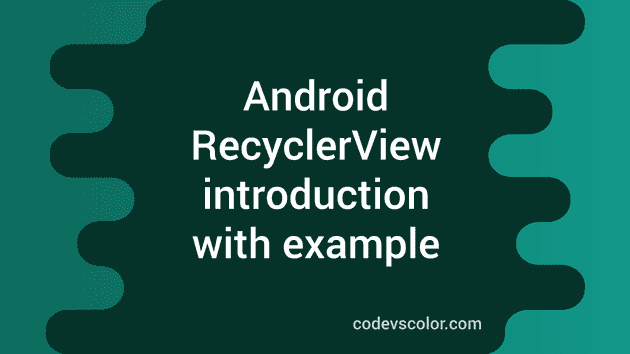Recyclerview was introduced as a replacement of ListView widget. Like listview, recyclerview is also used to display large set of items inside application. But recyclerview is more advanced and efficient than listview.
Introduction :
- Layout Manager :
- Layout manager basically defines the types of layout which will be used by recyclerview. Three types of layout managers are available :
- LinearLayoutManager : Used to display linear list inside RecyclerView
- GridLayoutManager : Used to display Grids
- StaggeredGridLayoutManager : Used to display staggered grids (i.e. grids with different heights)
- ViewHolder :
- ViewHolder belongs to the adapter of the RecyclerView. This class is used to define a ViewHolder object which is used by the adapter to bind it with a position .It keeps references to all the views of a recyclerview item, which decreses the overhead of creating new references every time an item is displayed.
RecyclerView adapter :
- RecyclerView adapters are binds with the ViewHolders. This adapter should extend a class called
RecyclerView.Adapterpassing a class that that implements the ViewHolder patterns. Next we need to override two methodsonCreateViewHolderandonBindViewHolderinside the adapter. First one is called when a new instance of the ViewHolder class is created and second one is called when the view is shown in the UI.
ItemDecoration :
- By default, recyclerView doesnot show any divider between its items. We need to create a custom
RecyclerView.ItemDecorationclass and it should be linked to the RecyclerView usingaddItemDecorationmethod.
-
Create a new sample application on Android Studio.
-
Add the following gradle dependency on your project’s build.gradle file :
compile 'com.android.support:recyclerview-v7:23.1.1'- Create one Activity MainActivity.java with its corresponding layout as activity_main.xml
public class MainActivity extends AppCompatActivity {
@Override
protected void onCreate(Bundle savedInstanceState) {
super.onCreate(savedInstanceState);
setContentView(R.layout.activity_main);
RecyclerView mRecyclerView = (RecyclerView) findViewById(R.id.recycler_view);
mRecyclerView.setHasFixedSize(true);
LinearLayoutManager mLayoutManager = new LinearLayoutManager(this);
mRecyclerView.setLayoutManager(mLayoutManager);
//create one adapter with a list of 50 elements
RecyclerViewAdapter mAdapter = new RecyclerViewAdapter(getDummyList());
mRecyclerView.setAdapter(mAdapter);
//create one item decoration object and add it to the recycler view
RecyclerView.ItemDecoration dividerItemDecoration =
new DividerItemDecoration(this, LinearLayoutManager.VERTICAL);
mRecyclerView.addItemDecoration(dividerItemDecoration);
}
private ArrayList<ListModelObject> getDummyList() {
ArrayList objectList = new ArrayList<ListModelObject>();
for (int i = 0; i < 50; i++) {
objectList.add(i, new ListModelObject("Recycler View Item -", i));
}
return objectList;
}
}<?xml version="1.0" encoding="utf-8"?>
<RelativeLayout xmlns:android="http://schemas.android.com/apk/res/android"
xmlns:tools="http://schemas.android.com/tools"
android:layout_width="match_parent"
android:layout_height="match_parent"
tools:context=".activity.MainActivity">
<android.support.v7.widget.RecyclerView
android:id="@+id/recycler_view"
android:layout_width="match_parent"
android:layout_height="match_parent"
android:scrollbars="vertical" />
</RelativeLayout>
- Create an adapter for the RecyclerView :
public class RecyclerViewAdapter extends RecyclerView
.Adapter<RecyclerViewAdapter
.ModelObjectHolder> {
private ArrayList<ListModelObject> mObjectList;
public RecyclerViewAdapter(ArrayList<ListModelObject> objectList) {
mObjectList = objectList;
}
@Override
public ModelObjectHolder onCreateViewHolder(ViewGroup parent,
int viewType) {
View view = LayoutInflater.from(parent.getContext())
.inflate(R.layout.layout_item, parent, false);
ModelObjectHolder dataObjectHolder = new ModelObjectHolder(view);
return dataObjectHolder;
}
@Override
public void onBindViewHolder(ModelObjectHolder holder, int position) {
holder.label.setText(mObjectList.get(position).getName());
}
@Override
public int getItemCount() {
return mObjectList.size();
}
//view-holder class
public class ModelObjectHolder extends RecyclerView.ViewHolder {
TextView label;
public ModelObjectHolder(View itemView) {
super(itemView);
label = (TextView) itemView.findViewById(R.id.textView);
}
}
}Here we are using the following layout_item.xml file as layout for RecyclerView items.
<?xml version="1.0" encoding="utf-8"?>
<LinearLayout xmlns:android="http://schemas.android.com/apk/res/android"
android:layout_width="match_parent"
android:layout_height="match_parent"
>
<TextView
android:id="@+id/textView"
android:layout_width="wrap_content"
android:layout_height="wrap_content"
android:textAppearance="?android:attr/textAppearanceMedium" />
</LinearLayout>Model Object class for recyclerView item is ListModelObject.java and it looks like as below :
public class ListModelObject {
private String mName;
public ListModelObject(String name, int i) {
this.mName = name + i;
}
public String getName() {
return this.mName;
}
}- For item Decoration, we are using the DividerItemDecoration class provided by Google :
package com.codevscolor.recyclerviewbasic.util;
import android.content.Context;
import android.content.res.TypedArray;
import android.graphics.Canvas;
import android.graphics.Rect;
import android.graphics.drawable.Drawable;
import android.support.v7.widget.LinearLayoutManager;
import android.support.v7.widget.RecyclerView;
import android.view.View;
public class DividerItemDecoration extends RecyclerView.ItemDecoration {
private static final int[] ATTRS = new int[]{
android.R.attr.listDivider
};
public static final int HORIZONTAL_LIST = LinearLayoutManager.HORIZONTAL;
public static final int VERTICAL_LIST = LinearLayoutManager.VERTICAL;
private Drawable mDivider;
private int mOrientation;
public DividerItemDecoration(Context context, int orientation) {
final TypedArray a = context.obtainStyledAttributes(ATTRS);
mDivider = a.getDrawable(0);
a.recycle();
setOrientation(orientation);
}
public void setOrientation(int orientation) {
if (orientation != HORIZONTAL_LIST && orientation != VERTICAL_LIST) {
throw new IllegalArgumentException("invalid orientation");
}
mOrientation = orientation;
}
@Override
public void onDraw(Canvas c, RecyclerView parent) {
if (mOrientation == VERTICAL_LIST) {
drawVertical(c, parent);
} else {
drawHorizontal(c, parent);
}
}
public void drawVertical(Canvas c, RecyclerView parent) {
final int left = parent.getPaddingLeft();
final int right = parent.getWidth() - parent.getPaddingRight();
final int childCount = parent.getChildCount();
for (int i = 0; i < childCount; i++) {
final View child = parent.getChildAt(i);
final RecyclerView.LayoutParams params = (RecyclerView.LayoutParams) child
.getLayoutParams();
final int top = child.getBottom() + params.bottomMargin;
final int bottom = top + mDivider.getIntrinsicHeight();
mDivider.setBounds(left, top, right, bottom);
mDivider.draw(c);
}
}
public void drawHorizontal(Canvas c, RecyclerView parent) {
final int top = parent.getPaddingTop();
final int bottom = parent.getHeight() - parent.getPaddingBottom();
final int childCount = parent.getChildCount();
for (int i = 0; i < childCount; i++) {
final View child = parent.getChildAt(i);
final RecyclerView.LayoutParams params = (RecyclerView.LayoutParams) child
.getLayoutParams();
final int left = child.getRight() + params.rightMargin;
final int right = left + mDivider.getIntrinsicHeight();
mDivider.setBounds(left, top, right, bottom);
mDivider.draw(c);
}
}
@Override
public void getItemOffsets(Rect outRect, int itemPosition, RecyclerView parent) {
if (mOrientation == VERTICAL_LIST) {
outRect.set(0, 0, 0, mDivider.getIntrinsicHeight());
} else {
outRect.set(0, 0, mDivider.getIntrinsicWidth(), 0);
}
}
}Run this project and it should be like below :

In our next tutorial, we will discuss about GridLayoutManager and how to add animation to RecyclerView items.
Source code for this project is available on GitHub . You can pull it from here.

